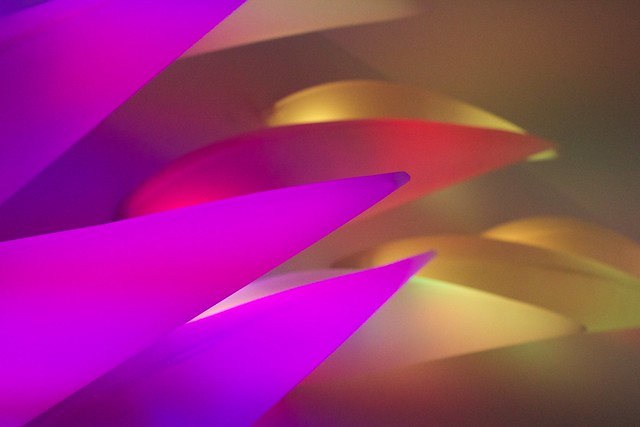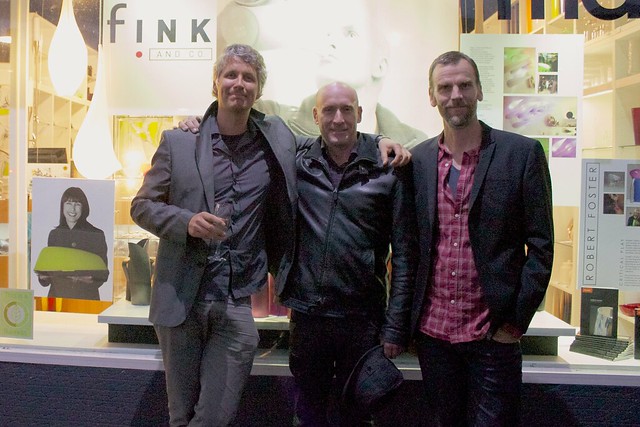May 1 2013 saw the launch of “Virga”; a data lighting sculpture produced in collaboration with renowned Australian designer Robert Foster of F!nk Design. Pat Coppel, of Make Designed Objects, invited Rob and I to complete the installation as part of the renovation of the flagship store in Carlton. If you’ve not had opportunity to visit, Make Designed Objects is a wonderful slice of Melbourne retail, brimming with amazing designer wares. It also has a significant online presence and the concept for the data sculpture was to create some kind of bridge between the bricks & mortar and online manifestations of the Make retail business. Pat describes the work:
Data Aesthetics in Retail Space is a collaborative project between Make Designed Objects, Robert Foster of Fink & Co and Geoff Hinchcliffe of University of Canberra’s Faculty of Arts & Design.
Virga (an observable streak or shaft of precipitation that falls from a cloud but evaporates or sublimes before reaching the ground) is the product of that collaboration; an LED light and data sculpture formed by internationally acclaimed designer-maker Robert Foster that colourfully expresses itself based on the digital data fed into its environment.
What data?
Any data we choose!
Want to watch a colourful representation of the seasonal nature of Make’s sales data?
Feed in the data.
The change in inner Melbourne maximum average daily temperatures from 1913-2013?
Feed in the data.With bricks and mortar retailers rapidly migrating to the World Wide Web why not bring a bit of the World Wide Web back into bricks and mortar retail? Why not feed the traffic data from the Make website into Virga and see what happens?
The real joy of Virga lies in its abstract representation of a digital world in a rapidly evolving bricks and mortar retail environment.
And it looks way cool…

The commissioning of Virga is clear evidence of Make’s ongoing commitment to building an exceptional retail experience – both on and offline. It’s refreshing to see when there is so much doom & gloom about the future of business for Australian retailers. As Pat Coppel explains:
In a market and world where increasingly we have a physical and virtual version of almost everything; people, businesses, streetscapes… it’s not surprising that online retail is booming. And while the news reports a great deal of fear for bricks and mortar retail, this ever changing market presents opportunities for innovation in brokering an extended relationship between the virtual and physical aspects of a retail business such as Make.
It is from within this landscape that Pat Coppel, Director of Make has initiated this collaboration between retailer, designer-maker and academic. The result is Virga; a beautiful sculptural installation that translates our technological data into a spectacular visual language of light and colour. As such, Virga creates a playful narrative around the virtual and physical instances of Make Designed Objects.

Now that the Carlton refurbishment is complete, Make are turning their attention to their online store and I’ll no doubt be posting about it soon. But for now, some details about the Virga development…
Virga is comprised of eleven individual lighting forms, each with two individually controllable RGBW (Red, Green, Blue, White) LED units. Inside each of the lighting forms is an Arduino mega with Wifly card for wireless network connection. The lighting array is orchestrated by a server-side application which parses the data and transmits instructions to each of the lighting units.
Each of the Arduinos acts as a simple slave and the heavy lifting is performed by the web server. The reasoning is that the Arduinos have a very limited amount of memory whereas the web server is powerful, fast and also much easier to edit and update than the physically concealed Arduinos.
Programming the Arduinos was new to me and coming from web scripting, the Arduino code seemed extremely brittle at first. However, it didn’t take too long to become acquainted and I was soon entranced by the wonder of working with something outside the screen. Fortunately I had the help of colleague Chris Hardy when it came to wiring the Arduinos to the LED lighting units. The trick was in finding the correct drivers for the LED units. Once the hardware was configured, I was able to experiment with the lights and get a feel for their tolerances and capabilities.
Ultimately the code I created for the Arduinos is akin to an animation class – its role is to understand lighting values as well as timing and transition values. One of the more difficult aspects of working with 11 independent asynchronous network devices is synchronising their timing. My solution was to create a sync process which is executed on start-up. It works like this: on start-up each unit connects to the network, checks-in with the server and awaits further instructions. The server logs the arrival of each lighting unit and stores an adjustment value for each. Once all units have checked-in, the server commences the choreography, sending each unit its time-adjusted lighting sequence.

In many respects, the delineation of roles and responsibilities on this project was determined by the particular expertise that Rob and I brought to the project. Rob crafted the lighting forms, including the custom mounts and housings for the LED units, while I took care of the data side of things; programming arduinos to control each lighting unit, and creating a server-side application to orchestrate the lighting array. But in this project the line between data and design was very blurry, and it required us both to be very hands-on at the meeting point of physical and digital. That meant lots of soldering of LEDs and testing in situ at the Make store.

I loved creating a work outside the LCD screen, working with hardware and collaborating with a designer whose knowledge of materials and material production is simply exceptional (I will have to do a post some time on Rob’s F!nk workshop and the astounding Jules Verne industrial contraptions he devises to realise his elegant design forms). It’s ironic that my “getting away from the LCD” project ultimately produces another screen analog; an array composition of pixel-like lighting forms. Mitchell Whitelaw’s eloquent article “AFTER THE SCREEN: ARRAY AESTHETICS AND TRANSMATERIALITY” highlights the interesting qualities and tensions in post-screen works such as Virga. Where the ubiquitous digital screen aims for generality (an ability to display any content at all) and self-effacing slightness (an attempt to disappear as a neutral substrate for content), Virga instead attempts to lower the resolution of the grid and emphasise the material presence of the array elements (Whitelaw). I think in the case of Virga, the tension between physical and digital is integral to its purpose: creating a dialogue between the physical and virtual manifestations of the Make business.


2 thoughts on “Virga”
Comments are closed.